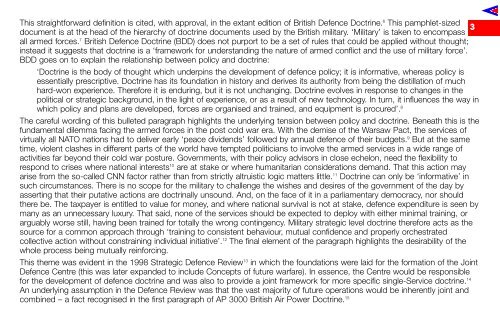THE ROYAL AIR FORCE - Air Power Studies
THE ROYAL AIR FORCE - Air Power Studies
THE ROYAL AIR FORCE - Air Power Studies
Create successful ePaper yourself
Turn your PDF publications into a flip-book with our unique Google optimized e-Paper software.
This straightforward definition is cited, with approval, in the extant edition of British Defence Doctrine. 6 This pamphlet-sized<br />
document is at the head of the hierarchy of doctrine documents used by the British military. ‘Military’ is taken to encompass<br />
all armed forces. 7 British Defence Doctrine (BDD) does not purport to be a set of rules that could be applied without thought;<br />
instead it suggests that doctrine is a ‘framework for understanding the nature of armed conflict and the use of military force’.<br />
BDD goes on to explain the relationship between policy and doctrine:<br />
‘Doctrine is the body of thought which underpins the development of defence policy; it is informative, whereas policy is<br />
essentially prescriptive. Doctrine has its foundation in history and derives its authority from being the distillation of much<br />
hard-won experience. Therefore it is enduring, but it is not unchanging. Doctrine evolves in response to changes in the<br />
political or strategic background, in the light of experience, or as a result of new technology. In turn, it influences the way in<br />
which policy and plans are developed, forces are organised and trained, and equipment is procured’. 8<br />
The careful wording of this bulleted paragraph highlights the underlying tension between policy and doctrine. Beneath this is the<br />
fundamental dilemma facing the armed forces in the post cold war era. With the demise of the Warsaw Pact, the services of<br />
virtually all NATO nations had to deliver early ‘peace dividends’ followed by annual defence of their budgets. 9 But at the same<br />
time, violent clashes in different parts of the world have tempted politicians to involve the armed services in a wide range of<br />
activities far beyond their cold war posture. Governments, with their policy advisors in close echelon, need the flexibility to<br />
respond to crises where national interests10 are at stake or where humanitarian considerations demand. That this action may<br />
arise from the so-called CNN factor rather than from strictly altruistic logic matters little. 11 Doctrine can only be ‘informative’ in<br />
such circumstances. There is no scope for the military to challenge the wishes and desires of the government of the day by<br />
asserting that their putative actions are doctrinally unsound. And, on the face of it in a parliamentary democracy, nor should<br />
there be. The taxpayer is entitled to value for money, and where national survival is not at stake, defence expenditure is seen by<br />
many as an unnecessary luxury. That said, none of the services should be expected to deploy with either minimal training, or<br />
arguably worse still, having been trained for totally the wrong contingency. Military strategic level doctrine therefore acts as the<br />
source for a common approach through ‘training to consistent behaviour, mutual confidence and properly orchestrated<br />
collective action without constraining individual initiative’. 12 The final element of the paragraph highlights the desirability of the<br />
whole process being mutually reinforcing.<br />
This theme was evident in the 1998 Strategic Defence Review13 in which the foundations were laid for the formation of the Joint<br />
Defence Centre (this was later expanded to include Concepts of future warfare). In essence, the Centre would be responsible<br />
for the development of defence doctrine and was also to provide a joint framework for more specific single-Service doctrine. 14<br />
An underlying assumption in the Defence Review was that the vast majority of future operations would be inherently joint and<br />
combined – a fact recognised in the first paragraph of AP 3000 British <strong>Air</strong> <strong>Power</strong> Doctrine. 15<br />
3

















